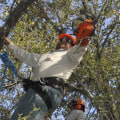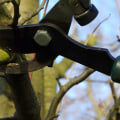The cold of winter is a protective shield for trees after pruning. Any cut in a tree, just like a cut in the skin, is an opening for infection. Microbes and pests can use these wounds as an entrance to the tree, which can cause the development of diseases. However, in winter, many pests are also dormant. It's important to never make a negative decision in a short time or when you're in a bad mood.
Late winter is the best time to prune, contain or rejuvenate overgrown shrubs and trees. Any branches cut during the winter will be able to recover quickly in spring with new growth. This will also minimize the amount of time you spend looking at a plant that looks like a bunch of sticks after rejuvenation pruning. Contrary to popular belief, pruning can be done at any time of the year; however, the recommended times vary according to the different plants. Pruning at the wrong time of year does not kill plants, but continuous and improper pruning results in damaged or weakened plants. Do not prune according to the convenience of the pruner, but when it causes the least damage to the plant.
The best time to prune most plants is in late winter or early spring before growth begins. There are exceptions to this rule, and they will be noted in the discussion of specific plant groups. The least desirable time is immediately after new growth develops in the spring. A large amount of food stored in roots and stems is used to develop new growths. This food must be replaced with new foliage before removing it, otherwise considerable dwarfism of the plant may occur.
This is a common problem found in pruning. In temperate regions, most plants remain dormant during the winter. This is the time of year when they have stopped active growth and have crouched for the cold. Because of this latency, late winter and early spring are usually the best times to make adjustments to the shape of many trees and shrubs. You want to prune hard in late winter or very early spring BEFORE any new growth starts. This allows the plant to put its energy into producing new, healthy growth when the warmer spring temperatures approach. Until the trees have been completely defoliated, some underlying problems are not obvious or cannot be seen, while other problems occur as the tree continues to grow.
Doing tree work during this period of inactivity has many benefits, both for your trees and for your wallet. However, when there is a risk of certain diseases, such as oak wilting, painting the wounds of tree pruning is an important protective measure. Despite the fact that a sleeping tree can better withstand these harmful types of pruning, the overall health of the tree can be irreparably harmed. To prune shorter trees yourself, look for tree clippers with long reach poles so you can keep your own feet safely on the ground. The central leader of a tree should not be pruned unless the leader is not wanted, as is the case with some naturally low-branched trees or where multi-stemmed plants are desired. It's a common misconception that tree maintenance can't be done during the winter months or that tree care companies don't work during this time of year.
In general, it is best for trees to do hard pruning or simply heavier pruning while the tree is dormant in the winter months. Pruning dead branches as you note them will help the tree heal faster to seal the area, which will keep your tree healthy and happy. The tree will have already used its energy to start a new growth, and it will not be able to recover from pruning as well or as quickly. The concept in the training of a tree called “poor quality trunk” refers to this gradual elevation of the lower branches of a tree. Hard tree pruning is when you reduce the overall size or heading towards the branches or simply thinning the canopy to allow air and sunlight in and cut up to 30% of the tree. While it is generally best to prune all trees in autumn and winter, it is important to consider the particular problems of a given species. In oaks in areas of Texas where oak wilt disease is prevalent, a wound dressing should be used to help prevent the bark beetle from spreading the disease through the pruned surface of a tree. In general, it is best for trees to do hard pruning or simply heavier pruning while the tree is dormant in the winter months. Pruning dead branches as you note them will help the tree heal faster to seal the area, which will keep your tree healthy and happy. The tree will have already used its energy to start a new growth, and it will not be able to recover from pruning as well or as quickly. The concept in the training of a tree called “poor quality trunk” refers to this gradual elevation of the lower branches of a tree. Hard tree pruning is when you reduce the overall size or heading towards the branches or simply thinning the canopy to allow air and sunlight in and cut up to 30% of the tree. While it is generally best to prune all trees in autumn and winter, it is important to consider the particular problems of a given species. In oaks in areas of Texas where oak wilt disease is prevalent, a wound dressing should be used to help prevent the bark beetle from spreading the disease through the pruned surface of a tree.
A common mistake when pruning young trees is to remove small branches from them, leaving only a tuft of leaves on top of the tree. Having an ISA-certified arborist examine your trees before pruning them is crucial to ensuring proper care.


